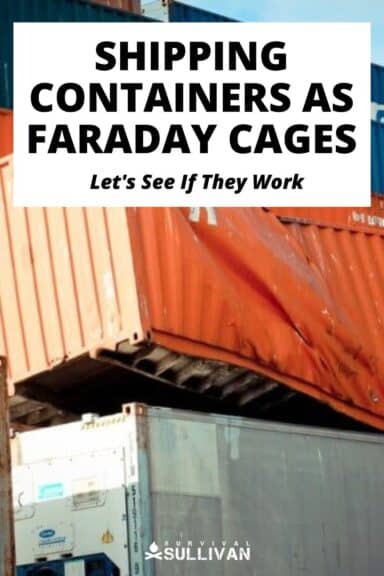Unless you have actually been living in a remote underground bunker for the past couple of decades, chances are pretty good that you are aware of the existential threat posed by EMPs.

Electromagnetic pulses, whether created by natural solar phenomena or man-made weapon systems of one kind or another, can potentially destroy our electrical grid and fry electronic devices and components in the blink of an eye. Talk about going back to the Stone Age!
That is, an EMP will do that unless your gear is protected inside a Faraday cage, a metallic enclosure that can block the emanations. Speaking of Faraday cages, would something like a shipping container make a good one?
Potentially. Most metal shipping containers are only so-so as designed when used as a Faraday cage since the fit between the doors and the body of the container could allow energy to reach the contents inside. Additional grounding and insulation are also needed to improve efficacy.
I’ve heard it from too many people lately talking about using a bone-stock shipping container as a Faraday cage, one that they can even potentially put vehicles and other large, bulky gear inside to keep it safe.
It’s a great idea, and I applaud the ingenuity, but I want to make them and everyone else aware of the fact that you must upgrade that container before you count on it. Keep reading, and I’ll tell you everything you need to know to do that.
How Does a Faraday Cage Work to Protect Against an EMP?
If you aren’t up to speed on EMPs and countermeasures against them, it’s worth taking a moment to discuss exactly what a Faraday cage is and how it protects gear and goods against the effects of an EMP.
The super short version is that an EMP is just a pulse or wave of electromagnetic energy, however it’s created.
The really powerful ones that we’re worried about, the kind that can implode our nation or even much of the globe, can induce high voltage currents in electrical networks and components, likely overloading them to a catastrophic degree.
A Faraday cage is nothing more than a metal box, cage, enclosure, bag, or wrapper that completely surrounds vulnerable gear and electronics, basically intercepting and blocking that harmful energy to let it dissipate into the ground or another surface.
If you look at it that way, it seems like a shipping container would certainly fit the bill, being made of metal, right?
Well, They Are Metal on All Sides…
Yes, shipping containers are made of metal on all sides, but in our use case that does not qualify them as an effective or certain Faraday cage.
That’s because a Faraday cage must permit absolutely no gaps that could allow the electromagnetic energy of the EMP to get inside. Any breach, any opening, any area that’s too thin or not completely joined, is a very real vulnerability that can destroy the items stored within.
Assuming the shipping container is in good repair, the sides, top, rear, and bottom of the container will certainly fit the bill. The weak point, though, is the doors.
Simply, shipping container doors just don’t fit together and close tightly enough to guarantee that an EMP won’t be able to “squirt” inside.
Simply, it’s a risk, and there’s been no major testing done using shipping containers as Faraday cages. All we have is theory and a precious few known quantities to go off of.
How Can You Improve a Shipping Container for Use as a Faraday Cage?
I don’t say all this to discourage you, and you shouldn’t give up if you want to adapt a shipping container to be used as a Faraday cage. It’s certainly possible!
In fact, some sellers and manufacturers of shipping containers have addressed this question because it comes up so much:
“The most important part of the container cage would be conducting the energy into the ground, so lightning rods on all four corners, at least 8-10′ deep connected to the container with copper wire is vital for success.”
ContainerAuction.com
The manufacturers of these containers say that the first thing you should do is put in a grounding rod on the outside of the container at least one of the corners, and preferably two or more. This will give that powerful current generated by an EMP somewhere to go and reduce the likelihood that it can get inside.
The next thing you’ll need to do is shore up the fit of the doors, making sure they close as tightly as possible and then preferably completely wrapping the seals, seams, and jambs with a conductive foil or mesh to block off those potential gaps…
Do these things, and you’ll probably be able to count on that shipping container as long as it’s in good shape and doesn’t have any breaks or holes in it.
Don’t Let Anything Inside the Container Touch the Walls.
One more thing to keep in mind. How you store the goods inside also makes a difference. Don’t let any of your gear inside touch any of the walls or ceiling. That will allow the electromagnetic energy that hits the skin of the container to jump directly to it and then damage or destroy it.
Easier said than done depending on how tightly you have your container packed.
And though these containers typically have a wood or rubber floor as a rule, I would strongly advise you to give it an extra layer of insulation in the form of foam, fiberglass, or thick rubber on all surfaces.
This will give you yet more assurance that your stuff will survive the event. If you can’t do that, can’t afford it, or just don’t want to go through with it, at least put down some extra insulation on the floor and keep your goods well away from the walls and ceiling.
Remember to protect that door and ground the container as described, and you should be okay.


Tom Marlowe practically grew up with a gun in his hand, and has held all kinds of jobs in the gun industry: range safety, sales, instruction and consulting, Tom has the experience to help civilian shooters figure out what will work best for them.

Steel is poor insulator against a full spectrum EMP. While it will protect against most frequencies, it will allow others to pass through. The contain would need to be made of aluminum to stop the frequencies that do the most damage. Even a pinhole can compromise the container. Having tested several materials for the purpose of preventing EMP damage, I found that a box lined with heavy duty aluminum foil will work and meet MILSPEC for EMP protection. The joints must be absolute and all surfaces in electrically conductive contact for it to work. Even a this layer of adhesive at a joint will cause failure unless you use conductive adhesive.
When testing we also found that grounding had no positive effect on the results.